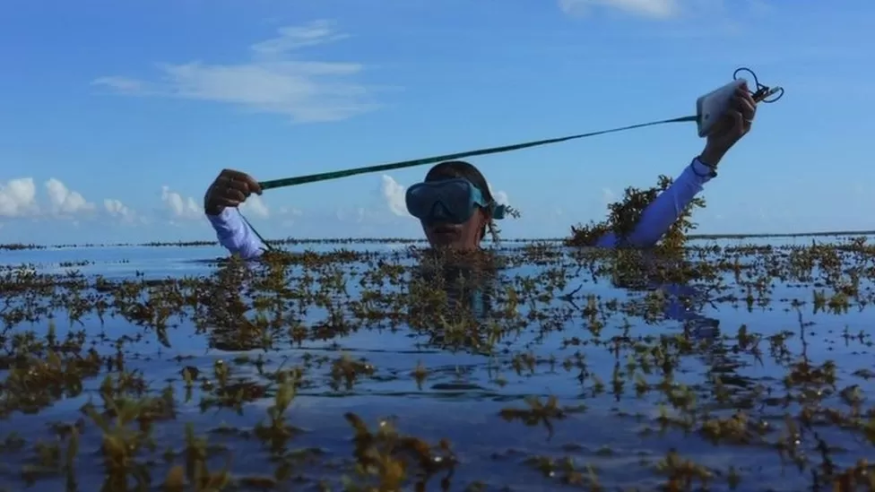Consider a vast kelp field and the extent of Croatia sailing across South America And Africa in the South Atlantic waters. Annually, it takes a billion tonnes of carbon dioxide away from the atmosphere and buries it in the ocean bottom, safe from mortal danger.
Scientists theorize that lowering greenhouse emissions will be insufficient, and carbon sequestration will be critical to preventing global warming. Furthermore, carbon capture systems have already been generally small-scale and have had limited effectiveness. However, a British entrepreneur intends to have this operational by 2026.
John Auckland, a business executive, feels he has this type of concept. He aims to capitalize on what he deems the "wondrous properties" of something like the flowing seaweed sargassum. He's certain that this Seafield's floating field will absorb adequate CO2 from the atmosphere to offset the impacts of climate change while simultaneously generating emissions reductions because of its supporters.
With its 55,000 square kilometers (21,200 square miles), Auckland is planning big. That must be enormous to make a difference inside the fifty gigatonnes of atmospheric co2 humans emit into the sky annually. The gigatonne was around a billion tonnes of carbon, which Auckland's mega-farm intends to absorb yearly.
Kelp Help in the Past
Two years ago, Louis Druehl paddled his boat, The Kelp Express, miles down the steep shoreline in Bamfield, a seaside hamlet in British Columbia, Canada. The ship has transported Druehl towards the coincidentally called Kelp Bay for the past 51 years, and strands of kelp that Druehl has just been painstakingly gathering for decades dangle under the surface of the liquid, as per Times.
Druehl, 84, became the first professional kelp operator in North America after he began making kelp, a brown moss, in 1982. Some consider him the "seaweed guru," whereas others dub him the "kelp grandfather." He had examined seaweed, cultivated it, served it, and even published an award-winning, best-selling book on it.
The Seaweed Project
Going back to Auckland, his campaign is now roundabout its technique throughout the Caribbean and Mexico and therefore is inspired by the concepts of marine scientist Professor Victor Smetacek. He had also long been attracted by the possibility of growing seaweed in massive spinning ocean circulation called gyres, according to Seafields.
"In the midst, they accumulate all types of items," he claims. "Of course, the most well-known illustrations are really the waste plastic piling amid the ocean gyres." Seafields intend to cage in its sargassum crop similarly as any of these huge vortices capture islands of drifting garbage. "The gyre simply prevents the sargassum from leaving," John Auckland continues.
Sargassum reportedly ravaged the Caribbean tourist industry for years. Whenever it splashes up on shore, its decomposition emits a foul smell. Not the appropriate location to lounge on a beachfront blanket, as reported by Science Times.
Nonetheless, Seafields is confident that this is unlikely to transpire using their seaweed. It states that any animals who break out from the field would be deprived of the minerals that the crew planned to siphon up from deep levels to sustain their crops, following the report from the UN Environment Programme.

Sea Gyre and Possible Harm Against Seafield
Because the evaporation from subtropical heat slams loose on it throughout the day, the seawater confined in gyres is highly salty and lacking in nourishment. This explains why Prof. Smetacek speaks to gyres as "the seas' deserts."
However, as all these deserts gradually shift, they pass over a cooler, nutrient-rich marine zone that the professor intends to pull towards the surface to assist the sargassum. "When we link the nutritionally large bodies of water using pipes and bring that water up from the bottom and allow it to warm up, then that will keep flowing on its own and remain running eternally," Prof Smetacek continues.
By early 2023, the plan is designed to validate its technology. Initially proposed in 1956, the saltwater fountain has already been successfully duplicated, although not on the large scale that Seafields intends.
Prof. Smetacek forecasts a bountiful harvest of sargassum if the salt fountain works to measure. He also envisions hovering collectors baling the crop and transporting it to the inactive levels of the ocean bottom; wherein there is such little oxygen that the bundles will not decay. Every carbon particle possessed will stay unchanged in the structure of the seaweed.
Seafield Still a Gamble?
The trials are still underway, but the team believes they can store collected carbon for thousands, if not hundreds, of years. Carbon trading opponents claim that the drive to monetize CO2 collection has led to supporters grossly overstating technology that ultimately comes up short of their professed goals.
Dr. Nem Vaughan, assistant professor of climate change at the University of East Anglia, argues that there are simpler, technologically demanding methods to influence the environment, such as adding more trees and heathland and safeguarding carbon-rich areas like peatlands. "It's way simpler to just let it in the earth rather than to try to trap it once it comes out." the kelp once collected the carbon.
However, John Auckland admits that some aspects of the system have yet to be authenticated, but he feels it is worth taking the risk. "We could genuinely make considerable achievements in tackling the climate catastrophe; we can't simply take this risk, and if everyone felt that way, no one would have been engaging in remedies of this level," he added following the report from BBC.
Check out more news and information on Seaweeds in Science Times.










